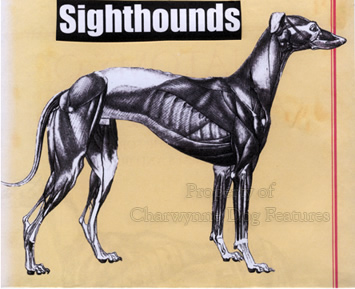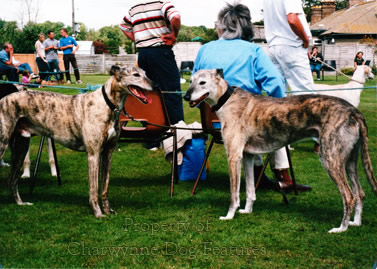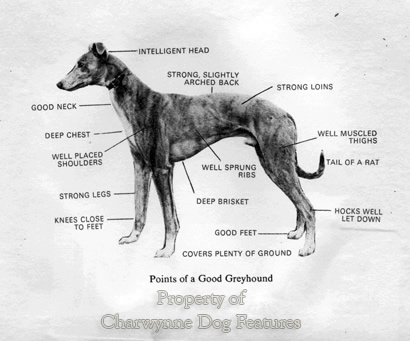396 THE ANATOMY FOR SPEED
SIGHTHOUND CRITERIA - THE ANATOMY FOR SPEED
by David Hancock
 Speed with Endurance
Speed with Endurance
The sighthound silhouette is unmistakeable: long legs, long back, long muzzle, it’s hardly surprising they are often all called long dogs! But the seeking of great pace creates the need for those features, with the requirement for endurance only just a secondary requirement. Foxhounds, huskies and wolves, especially, have great endurance but do not rely on sheer speed; the sighthound build and its musculature demonstrate the priority, it’s an anatomy for immense pace, sustained pace but not for mile after mile, as the packhounds, wolf-packs and the sled-dogs need. Of a Greyhound’s live weight, roughly 57% is accounted for by muscle. This compares with around 40% for most mammals. During exercise, a Greyhound can increase its packed (blood) cell volumes by between 60 and 70%, and increase its heart beat from below 100 to over 300 per minute; this allows a much more effective blood flow to its muscles than is the case in most other breeds. The Greyhound’s thigh muscles are far better developed than in most other breeds, facilitating pace.
Unique Build
The particular function of each sporting dog not surprisingly led to the development of the physique which allowed the dog to excel in that function. That is why sighthounds have a muscular light-boned build, the terriers a low-to-ground anatomy and the flock guardians substantial size. Sighthound breeds, wherever they were developed, project the same silhouette, display the same racy phenotype. The Azawakh of Mali, the Harehound of Circassia, the Sloughi of Morocco and the Tasy or Taigon from Mid-Asia would never change hands if they didn't look like fast-running dogs. If they didn't possess this anatomical design they couldn't function as speedsters. The hounds from the Mediterranean littoral have upstanding ‘bat’ ears to maximize their already acute hearing; this is an ear-shape not favoured further north, partly because of the harm inflicted to such ears by freezing winds and driving rain.
Breed Differences
Whilst the sighthound breeds have a common silhouette, the differences in their hunting styles, hunting country and the local climate have produced small but key differences, such as ear-shape, between the various breeds in the group. All need the long loin to provide flexibility in the fast gallop, a deep chest to enable lung power and immense propulsion from the rear. Sighthounds need length in the forearm to facilitate the fast double-suspension gallop. The Ibizan Hound has a different front from most of the sighthounds, designed to allow greater jumping agility. It displays a noticeable ‘hover’ in its gait. The Whippet has more tuck-up and loin-arch than the Mediterranean breeds. The Greyhound, from the side view, shows the anatomy its users have learned provides speed in the gallop. The shoulder blade is not as well laid-back as in say the ‘endurance’ breeds, like the sled-dogs, and the upper arm is more open than in a non-sporting breed, with a proportionately longer fore arm. The Greyhound’s front pasterns are long and sloping due to the immense ‘bend’ needed there at great pace. Many Saluki owners prefer the smaller, more energy-efficient type, since the breed is expected to cover substantial distances in the heat at the trot. The ratio of weight to height matters when speed with stamina is sought.
Weight Significance
The weight of successful coursing Greyhounds is worth a glance. The renowned Master McGrath was around 53lbs, Bit of Fashion was 54lbs, Golden Seal, Staff Officer, Guards Brigade, White Collar and Fitz Fife were each around 65lbs but Shortcoming only 49lb. Lobelia won in 1867 weighing just over 44lbs. I believe that Coomassie was the smallest Greyhound that ever won the Waterloo Cup, weighing in at just 44lbs. (A little bitch called Swift was very successful at Plumpton in the period 1879-1882, weighing a mere 34lbs.) Cerito, a white bitch weighing 50lbs, won in 1850 and twice subsequently. In 1881, a dog described as ‘very smart and clever’, Princess Dagmar, won the Waterloo Cup and was then considered to be a big bitch at 58lbs. The truly great track dog, Mick the Miller, was 64lbs at peak fitness. Alvaston Lulu Belle, weighed only 45lbs when she broke the track record for 810yds at Catford. More recently, Cash for Dan weighed 89-90lbs when winning the 1969 BBC Television Trophy. Our show Greyhound has no stipulation regarding weight but its ideal height, for a male dog, is desired at 28-30 inches. A Deerhound dog of 30 inches at the withers would weigh around 100lbs. Does a Greyhound need to be 30" high and approaching a hundredweight? At the end of the last century, the Waterloo Cup was twice won by dogs weighing over 90lbs; this has been put down to the Irish breeding for sheer speed in ‘park’ coursing (hares released in an enclosed setting). The American KC standard sets the Greyhound's weight at 65-70lbs for a dog and 60-65lbs for a bitch. I don’t believe that the giant lurchers I see at some country shows would make effective hare-hunters, however fast in the short sprint.
Fit for Function
But I do see more correctly-constructed 'greyhound-lurchers' than I do show Greyhounds. This is a comment rather than a criticism, because I see many more of the former than the latter. It is worrying however to see a lack of muscle on show Greyhounds and at times a slab-sidedness which affects type as well as function. Sporting breeds must be judged in any ring on their ability to carry out their specific historic function, if not then there is really little point in breeding them. This ability was summed up by the esteemed ‘Stonehenge’, when writing on the Greyhound anatomy over a century ago: “This framework, then, of bones and muscles, when obtained of good form and proportions, is so gained towards our object; but still, without a good brain and nervous system to stimulate it to action, it is utterly useless; and without a good heart and lungs to carry on the circulation during its active employment, it will still fail us in our need.” Running dogs need heart in every sense.
Pace Based on Extension
The sighthound build is a superb combination of bone and muscle, a unique balance between size/weight and strength and quite remarkable coordination between fore and hind limbs. The Greyhound sprints in a series of leaps rather than running in a strict sense. It is what is termed a 'double-flight' runner, where the feet are all off the ground at the same moment. This is unlike a 'single-flight' animal like the horse which, when racing, nearly always has at least one foot on the ground. The Greyhound's leaping gait is rooted in quite exceptional extension, especially forward with the hind legs, but also rearwards with the front legs. Anatomically, the most vital elements in such a dog are the shoulders, and their placement, and the pelvic slope, which determines the forward extension of the all-important hindlimbs. That's where the power comes from. It always saddens me to see a sighthound in the show ring displaying upright shoulders and short upper arms, together with a lack of pelvic slope. It is even sadder when such an exhibit is placed by an ignorant judge – having been entered by an ignorant owner! I see these fundamental anatomical faults being condoned at far too many championship dog shows, but why can’t the owner/breeder see such basic flaws?
Forequarter Construction
The racing front involves an extremely long upper arm, often dropping the elbow below the brisket line. I have heard show judges declare this feature to be undesirable, even 'shelly'. But most of the desert Salukis I have seen hunt with great success possessed this feature, as do many quality lurchers. In the Dachshund front, the whole forehand structure is reduced in length of bones; the elbow action arc being actually above the brisket line. Many dogs that are loose at elbow are tight at the shoulder joint, the forelegs tending to be thrown out sideways in a circular movement. If the dog is tight at elbow the whole leg inclines outwards, making the dog 'paddle', ie move the feet in an arc to the side. Loose elbows are often accompanied by other front leg faults: slack pasterns, splayed feet or feet that turn in or out. Dogs with correctly sloping shoulders and compatible upper arms rarely have such a problem. Yet, Oliver Coughlan’s coursing Greyhound Spring Tide stood with both front feet turned outwards, but was unbeaten as a puppy, going on to win the Waterloo Purse. He never suffered from lameness, often associated with such a foot feature. Pigeon-toes generally go with a strong front, able to cope with impact from, say, a rolling tumble or a straightforward collision.
Shoulder Angulation
For over a century, dog writers and show judges have insisted that the correct angulation for the forequarters of the dog, the slope of the shoulder, should be 45 degrees. (This originally referred to a 45 degree angle between the slope of the scapula and the horizontal, not, as some state, the angle between the scapula and the upper arm). This has never been the case in sighthounds and is being vigorously challenged in all sporting breeds, after compelling evidence from cineradiography or moving X-rays. American experts Rachel Page Elliott and Curtis M Brown have produced convincing evidence to show the standing dog, in most breeds, displays a 30 degree slope, with sighthounds featuring as much as 10 degrees less. An exaggerated long forward reach is not essential for the sighthound, but immense extension is, both fore and aft. In a letter to Dog World a year or so ago, lurcher expert Jackie Drakeford, quite rightly corrected the words of a contributing vet-author by stating: 'Any working-bred hound or terrier will show how far forward the forelimbs need to be set, and there is never a 'ship's prow' chest in a true working dog...Anyone who has ever seen a running dog tight on the tail of hare, fox, rabbit or deer would know just how well they can twist and turn with those long backs and forelimbs set for forward reach.' Those valuable words sum up so succinctly the importance of the front assembly in all sighthounds. The power will always come from the back, but the manoeuvrability comes from the front.
Quality in the Neck
In his little-known book on the Greyhound of 1937, BA McMichan, the official vet to The Greyhound Breeders and Trainers Association in Australia covered the sighthound’s neck quite admirably, writing on this physical feature: “…is peculiarly graceful, and its length, symmetry, and set-on are of vital importance. It must be of sufficient length and flexibility to enable him to strike his hare without losing his stride. A ewe-neck, i.e. one that is concave above and convex beneath instead of the reverse, is a terrible fault, and one seldom met with, for the simple reason that all puppies so afflicted are, as a rule, promptly destroyed. If the tape is run from the point of the nose to that of the shoulder, the junction of the head with the neck, will, in a well-formed dog, be found to be midway. This fact is mentioned by ‘Stonehenge’ and is well worth remembering; for when the test fails it will be found that either the head or the neck is too short for well-balanced symmetry. A long, graceful, and well-set neck adds to that vague (but to experts, well understood) term, quality.” There is knowledge, experience and wisdom behind these words.
Handicapping Features
When shoulders are correctly sloped, the topline runs through much more smoothly, giving a far cleaner look. The shortening of the neck from the forward placement of the shoulders does seriously impede a working dog. In retrieving, for example, a sighthound with such a feature has to make so much more effort to pick up game or carry it over an obstacle. Short-necked dogs tire far more quickly than soundly constructed ones. No working dog deserves incompetent breeding bestowing handicapping features on it. When moving, 60 to 70% of a dog's weight is distributed on the front legs; the forequarter construction decides the soundness of the dog's movement. Long-arched necks provide flexibility for the head carriage and usually go along with good shoulder placement, the two combining to give the sighthound a look of quality and style. Long cervical bones, long dorsal bones, good neck length, adequate upper arm length and a gap between the scapulae at the withers are not difficult to detect when viewing and 'going over' an exhibit. R H Smythe, sportsman, vet, writer and exhibitor, once owned a brace of highly successful show Greyhounds, both over 27" in height, which could outrace a hare but never catch one. He also had a coursing Greyhound, 25" high, with 2½ fingers' width between the blade-bones, which once picked up 57 rabbits in three hours 'lamping' in similar country. The show Greyhounds were handicapped dogs, in the physical sense. But the only way to test the anatomy of a sighthound is a long way from the show bench - in the field and in pursuit of a fast and agile quarry.